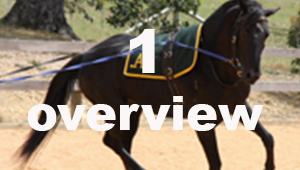
Long-Reining - Overview
In this video series you will learn how to long-rein your horse. From habituating your horse to the lines to perfecting canter transitions in a soft outline - this series takes you through the step-by-step process.
Purpose:
The purpose of this lesson series is to teach your horse to long-rein (long-line).
Long-reining is similar to lunging however the horse is travelling in frame, learning softness in the bridle, self-carriage and building top-line (all those muscles he will need to carry you). This is an educational exercise and prepares the un-started horse for riding, helps rehabilitate after an injury and is a great asset to any horse's education.
Training Information
Suitable For: All horses (2 years +)
Videos in Course: 5
This course will teach you how to long-rein your horse – one of the most useful and educational tools you will find.
Basic Lesson Elements:
The SPOT on the horse that you want to move: The horse travels in a circle, staying in frame, using his top-line and remaining light in the bridle
The DIRECTION you want it to go: In a circle and changing direction while maintaining frame.
The MOTIVATION for moving it: rein pressure for frame and lunge whip for forward movement
The REWARD given for the correct response: Release of the rein and whip pressure and praising the horse.
Prerequisites:
- Bridling and 'give to the bit'. It is important that the horse learns softness in the bridle and travelling in frame (give to the bit work) before teaching long-reining.
- The horse must be comfortable wearing a saddle or a surcingle. Un-started horses should have completed the 1st saddling lessons.
ISES Training Principles:
- Release the pressure immediately when the horse responds. Considering the lunge whip to go forward - be sure to point the whip to the ground when the horse is moving forward. If you don't do this you will, in essence, be chasing the horse (and numbers 6 and 8 will then not be achievable).
- Use signals that the horse can differentiate. When you want your horse to turn on the long-reins it is important to release all of the pressure from the 'old inside rein' before picking up pressure on the 'new inside rein' as holding pressure on both reins will lead to confusion.
- Train and initiate responses one at a time (shaping). There are a lot of different things going on with long-reining. The horse must learn to go forward, stay in frame, maintain rhythm, gait and balance and do transitions. We must build on these things one at a time, shaping them into the behaviour we want. As you work through the lessons you will discover the order in which the horse needs to learn the various elements.
- Train habitual responses using consistency and repetition. Long-reining is a great place to teach your horse useful habits such as canter to the 'kiss' sound. When used consistently and repetitively the horse soon develops the habit of cantering when he hears the kiss - no more kicking into canter under saddle, he will be pleased!
- Train only one response per signal. Your horse will already have learned the give to the bit work (at least from the ground for those that are not yet under saddle) so he knows quite a lot about travelling in frame. This is different because we now have 2 reins and we are further away from the horse. Be sure to break it down enough for the horse and train one element at a time as described in the lessons - don't go out and expect your horse to a beautiful uphill canter on the long-reins on day one (it will come but one thing at a time).
- Avoid fear during training. The following lessons will guide you through a step-by-step process of habituating your horse to the long-lines. It is essential that your horse is not stressed or fearful during the process. It is not unusual for horses to be afraid of the lines themselves, especially those that have been chased on the lunge, so the process and time it takes to habituate each horse will vary but it is absolutely essential.
- Train persistence of responses. Due to the length and weight of the reins, it is harder to completely release pressure when long-reining but it is no less important. When the horse is travelling in self-carriage we need to be sure that there isn't any pressure on the reins as constant rein pressure will simply desensitize the horse to that signal and ever-increasing amounts of pressure will be required for the same response in the future.
- Check for relaxation. As the horse is some distance from you when long-reining it is easy to check for relaxation and conflict behaviours. Is the horse swishing his tail, hollowing his back, raising his head, jamming into a frame, rushing or showing some other conflict behaviour? If so that needs to be addressed immediately. Long-reining is a great place to build top-line muscle, freedom and regularity in gait, transitions and many other things but it all starts with relaxation.
 ISES Training Principles
ISES Training PrinciplesInternational Society for Equitation Science's Training Principles Poster
